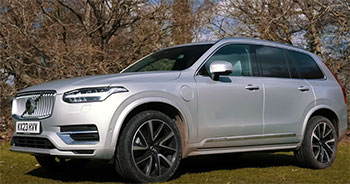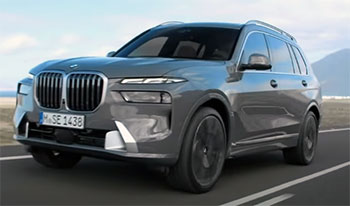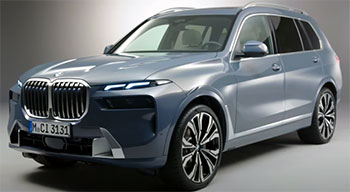I’ve been on the hunt for a luxury SUV that balances power, comfort, and practicality for my family’s needs, and I know you’re likely in the same boat. The BMW X7 and Volvo XC90 are two heavyweights in the three-row luxury SUV segment, each offering a unique blend of style, tech, and performance.
In this article, I’ll walk you through my experience comparing these vehicles, highlighting their pros and cons, key features, and which one might suit you best. Let’s get started with a side-by-side comparison to set the stage.
Comparison Table: BMW X7 vs. Volvo XC90
| Feature | BMW X7 (xDrive40i M Sport) | Volvo XC90 (B6 Ultimate) |
|---|---|---|
| Starting Price | $85,475 | $58,695 |
| Engine | 3.0L Turbo Inline-6, 375 hp | 2.0L Turbo + Supercharged + Hybrid, 300 hp |
| Fuel Economy (MPG) | 20/24/22 (City/Hwy/Comb) | 23/30/26 (City/Hwy/Comb) |
| Cargo Space (cu. ft.) | 12.8 (all seats up), 90.4 (max) | 12.6 (all seats up), 85.7 (max) |
| Seating Capacity | 7 (6 with captain’s chairs) | 7 (6 with captain’s chairs) |
| 0-60 mph | ~5.8 seconds | ~6.1 seconds |
| Infotainment Display | 14.9-inch touchscreen | 11.2-inch touchscreen |
| Safety Rating | Not yet tested by Euro NCAP | 5/5 NHTSA, IIHS Top Safety Pick |
| Towing Capacity | 7,500 lbs | 5,000 lbs |
| Warranty | 4 years/50,000 miles | 4 years/50,000 miles |
My Journey Comparing the BMW X7 and Volvo XC90
When I set out to compare the BMW X7 and Volvo XC90, I wanted to approach it as you might: as someone looking for a vehicle that’s not just a mode of transport but a statement of lifestyle, a family hauler, and a tech-savvy companion. Both SUVs promise luxury, but they deliver it in distinct ways.
I spent time test-driving these models, poring over specs, and imagining how they’d fit into daily life—whether it’s school drop-offs, weekend getaways, or long road trips. Here’s what I found.
Performance: Power Meets Efficiency
BMW X7: A Thrill-Seeker’s Dream

The BMW X7 xDrive40i M Sport, with its 3.0-liter turbocharged inline-six engine, pumps out 375 horsepower and 520 Nm of torque.
When I floored it during my test drive, the acceleration was exhilarating—hitting 0-60 mph in about 5.8 seconds felt like a sports car trapped in an SUV’s body.
The eight-speed automatic transmission shifted smoothly, and the air suspension soaked up bumps while keeping the ride taut and controlled.
It’s the kind of vehicle that makes you want to take the long way home just to enjoy the drive.
However, that power comes at a cost. The X7’s fuel economy—20 MPG city, 24 MPG highway, and 22 MPG combined—isn’t terrible for a vehicle of its size, but it’s not winning any awards for efficiency.
I noticed the fuel gauge dipping faster during spirited drives, which might sting if you’re commuting daily or covering long distances. Still, the X7’s towing capacity of 7,500 pounds is a boon if you’re hauling a boat or trailer for weekend adventures.
Pros:
- Punchy 375-hp engine delivers thrilling performance
- Smooth air suspension enhances ride quality
- Impressive 7,500-pound towing capacity
Cons:
- Fuel economy lags behind competitors
- Higher trims like the ALPINA XB7 drop to 17 MPG combined
Volvo XC90: Efficiency with a Side of Power

The Volvo XC90 B6 Ultimate, with its 2.0-liter turbocharged and supercharged engine paired with a mild hybrid system, produces 300 horsepower and 420 Nm of torque.
My test drive revealed a surprisingly peppy ride, hitting 0-60 mph in around 6.1 seconds.
It’s not as visceral as the X7, but it’s no slouch either. The eight-speed automatic felt refined, and the standard all-wheel drive provided confident traction on wet roads.
What impressed me most was the XC90’s fuel efficiency. With EPA estimates of 23 MPG city, 30 MPG highway, and 26 MPG combined, it’s noticeably thriftier than the X7. For those who prioritize green credentials, the XC90 Recharge plug-in hybrid variant offers an astounding 58 MPGe combined and about 40 miles of electric-only range.
I could see this being a game-changer for short commutes or city driving, though you’ll need to plug it in regularly to maximize savings.
Pros:
- Superior fuel economy, especially in hybrid form
- Smooth and confident handling with standard AWD
- Plug-in hybrid option for eco-conscious drivers
Cons:
- Less horsepower than the X7
- Towing capacity limited to 5,000 pounds
Interior: Luxury That Feels Like Home
BMW X7: A Tech-Forward Palace
Stepping into the BMW X7 feels like entering a high-tech lounge. The cabin is impeccably crafted, with Merino leather upholstery in higher trims and a 14.9-inch touchscreen dominating the dashboard. During my time in the X7, I loved the intuitive iDrive system, which paired with the digital driver display to create a seamless tech experience. The four-zone climate control kept everyone comfortable, and the panoramic moonroof added an airy feel to the spacious interior.
However, I noticed the third-row seats were a bit cramped for adults—better suited for kids or short trips. Cargo space is generous, with 12.8 cubic feet behind the third row and up to 90.4 cubic feet with the second row folded, but I found the second-row legroom (37.6 inches) slightly tighter than I’d hoped for a vehicle this size. Still, features like heated and ventilated front seats and a 16-speaker Harman Kardon sound system made every drive feel indulgent.
Pros:
- Premium materials and build quality
- Large, user-friendly infotainment system
- Ample cargo space with seats folded
Cons:
- Third-row seating is tight for adults
- Second-row legroom slightly limited
Volvo XC90: Scandinavian Serenity

The Volvo XC90’s interior is a masterclass in minimalist luxury. The quilted Nordico upholstery (or Nappa leather in higher trims) feels custom-crafted, and the Scandinavian design—clean lines, natural wood accents—creates a calming atmosphere.
I spent a long afternoon in the XC90, and the 11.2-inch touchscreen, while smaller than the X7’s, was responsive and paired with a crisp 10-speaker audio system.
The HomeLink system, standard on the XC90 but absent in the X7, was a nice touch for garage-door convenience.
The XC90 shines in passenger comfort. With 40.9 inches of front legroom (compared to the X7’s 39.8 inches), it feels more spacious up front. The third row is marginally more usable than the X7’s, though still best for kids. Cargo space is slightly less than the X7’s, with 12.6 cubic feet behind the third row and 85.7 cubic feet max, but I found it sufficient for family road trips.
The air suspension on higher trims provided a cushioned ride, though I noticed some road noise at highway speeds.
Pros:
- Spacious and comfortable front seating
- Elegant, minimalist interior design
- Standard HomeLink and four-zone climate control
Cons:
- Slightly less cargo space than the X7
- Some road noise on highways
Safety: Who’s Got Your Back?
BMW X7: Robust but Untested
The BMW X7 comes loaded with safety features like auto emergency braking (AEB), pedestrian and cyclist detection, lane-keeping assist, and a reversing camera. I felt confident navigating tight city streets thanks to the Parking Assistant Professional and Trailer Assistant. However, the X7 hasn’t been tested by Euro NCAP yet, so there’s no definitive crash-test rating to lean on. Still, its size and seven airbags suggest it’s a safe bet. One downside? Blind-spot assist isn’t standard, which feels like an oversight for a vehicle in this price range.
Pros:
- Comprehensive standard safety features
- Advanced parking and towing aids
- Solid build quality for occupant protection
Cons:
- No Euro NCAP rating yet
- Blind-spot assist not standard
Volvo XC90: The Safety Champion
Volvo’s reputation for safety is legendary, and the XC90 lives up to it. It earned a 5-star NHTSA rating and an IIHS Top Safety Pick award for six consecutive years. During my test drive, features like the Blind Spot Information System, Lane Keeping Aid, and Adaptive Cruise Control worked seamlessly, giving me peace of mind in heavy traffic. The XC90’s pilot assist system felt like a co-pilot, gently correcting my steering on long drives. If safety is your top priority, the XC90 is hard to beat.
Pros:
- Stellar safety ratings from NHTSA and IIHS
- Comprehensive driver-assistance suite
- Intuitive pilot assist system
Cons:
- Some touchscreen controls require extra focus
- Auto-parking feature can be finicky
Technology: Gadgets Galore
BMW X7: A Tech Powerhouse
The X7’s tech suite is a highlight. The 14.9-inch touchscreen, paired with a 12.3-inch digital driver display, feels like a command center. I found the iDrive system intuitive, with crisp graphics and quick responses. Wireless charging, a 10-speaker audio system, and standard connectivity options like Apple CarPlay and Android Auto made every drive enjoyable. Higher trims add luxuries like a Harman Kardon sound system and heated rear seats, but I wished some of these were standard given the X7’s price.
Pros:
- Large, responsive infotainment system
- Seamless smartphone integration
- Premium audio options
Cons:
- Some advanced features reserved for higher trims
- Pricey optional extras
Read More: My Thoughts On Acura MDX Vs. Lexus GX
Volvo XC90: Smart and Accessible
The XC90’s 11.2-inch touchscreen is slightly smaller but still user-friendly, with clear menus and fast response times. I appreciated the standard HomeLink and wireless charging, which aren’t always included in competitors’ base models. The 10-speaker audio system delivered crisp sound, and higher trims offer a Harman Kardon upgrade. While the XC90’s tech is impressive, some touchscreen controls—like climate settings—required a few extra taps, which could be distracting on the move.
Pros:
- Intuitive infotainment with standard HomeLink
- Strong connectivity and audio options
- Clean, uncluttered interface
Cons:
- Touchscreen controls can be cumbersome
- Smaller display than the X7
Price and Value: Bang for Your Buck
BMW X7: Premium Price, Premium Experience
The BMW X7 xDrive40i M Sport starts at $85,475, a significant jump over the XC90. Higher trims like the M60i or ALPINA XB7 can push past $100,000, which might give you pause if you’re budget-conscious. During my research, I found the X7’s price justified by its powerful engine, luxurious interior, and advanced tech, but the optional extras add up quickly. For example, metallic paint can cost an extra $2,400, and some safety features aren’t standard. If you want top-tier performance and don’t mind the cost, the X7 delivers.
Pros:
- High-end performance and luxury
- Robust towing and cargo capabilities
- Prestigious brand appeal
Cons:
- Steep starting price
- Expensive optional features
Volvo XC90: Affordable Luxury
The Volvo XC90 B5 AWD starts at $58,695, making it a relative bargain in the luxury SUV segment. The B6 Ultimate, at around $70,000, still undercuts the X7 while offering comparable features. The plug-in hybrid Recharge model adds value for eco-conscious buyers, with lower running costs thanks to its 58 MPGe. I found the XC90’s standard equipment—like AWD, HomeLink, and four-zone climate control—impressive for the price, though fully loaded models can approach X7 territory.
Pros:
- Lower starting price
- Generous standard features
- Cost-saving hybrid option
Cons:
- Less powerful base engine
- Top trims less luxurious than X7
Driving Experience: On the Road
BMW X7: Dynamic and Engaging
Driving the X7 is a joy. Its powerful engine and responsive steering make it feel lighter than its 5,600-pound frame suggests. I took it on winding backroads and found the air suspension kept body roll in check, while the adaptive dampers smoothed out imperfections. However, the X7’s size can be a handful in tight parking lots, and I noticed some road noise at higher speeds. If you crave a sporty drive in a luxury package, the X7 delivers.
Pros:
- Sporty handling for a large SUV
- Smooth and powerful acceleration
- Comfortable on long drives
Cons:
- Bulky in tight spaces
- Some road noise at highway speeds
Volvo XC90: Smooth and Composed
The XC90’s driving experience is all about serenity. Its air suspension (on higher trims) provides a cushioned ride, and the light steering made city driving a breeze. I navigated narrow streets with ease, thanks to the XC90’s excellent visibility and camera systems. On the highway, it felt composed, though not as dynamic as the X7. The hybrid model’s electric mode was nearly silent, perfect for urban commutes. However, the XC90’s ride quality can feel busy over rough roads, and the engine lacks the X7’s raw power.
Pros:
- Comfortable, quiet ride in hybrid mode
- Excellent visibility and maneuverability
- Smooth handling in city settings
Cons:
- Less engaging than the X7
- Ride can feel busy on rough roads
Ownership Experience: Long-Term Considerations
BMW X7: Prestige with a Price
Owning a BMW X7 comes with a certain cachet, but it’s not without caveats. The four-year/50,000-mile warranty is solid, but maintenance costs can be high, especially for a performance-oriented SUV. In my research, I found mixed reviews on reliability, with some owners reporting issues with electronics. Resale value is decent, with the X7 losing about 55% of its value over five years, but it trails the XC90 slightly. If you’re after prestige and performance, the X7 is worth it, but budget for upkeep.
Pros:
- Strong brand prestige
- Decent resale value
- Comprehensive warranty
Cons:
- Higher maintenance costs
- Mixed reliability reports
Volvo XC90: Practical and Dependable
The XC90 offers a compelling ownership proposition. Its lower starting price and better fuel economy (especially in hybrid form) keep running costs down. Volvo’s lifetime parts warranty is a unique perk, starting from the purchase date and covering parts replaced under warranty. Reliability ratings are strong, and the XC90 retains 0.6% more value than the X7 over five years. During my time with the XC90, I appreciated its practicality for family life, though some owners note minor infotainment glitches.
Pros:
- Lower ownership costs
- Strong reliability and resale value
- Lifetime parts warranty
Cons:
- Minor infotainment issues
- Less prestigious than BMW
Who Are These SUVs For?
The BMW X7 is for you if you crave a dynamic driving experience, premium tech, and the status of a luxury brand. It’s ideal for those who prioritize performance and are willing to pay for it, whether towing a trailer or turning heads in the carpool lane. However, its higher price and thirstier engine might not suit budget-conscious buyers.
The Volvo XC90 is your pick if you value safety, efficiency, and Scandinavian elegance. It’s perfect for families who need a practical, comfortable SUV with lower running costs, especially in hybrid form. If you don’t need the X7’s raw power, the XC90 offers tremendous value without sacrificing luxury.
Read More: My Thoughts On Acura MDX Vs. Volvo XC90
Frequently Asked Questions (FAQ)
No, the BMW X7 is slightly larger in exterior dimensions, but the XC90 offers more front legroom and comparable cargo space.
Volvo generally has a stronger reliability reputation, with the XC90 earning higher marks in owner surveys and a lifetime parts warranty.
The BMW X5, Audi Q7, or Genesis GV80 may appeal if you prioritize performance, handling, or specific luxury features, but it depends on your needs.
The BMW X7 is comparable to the Volvo XC90, Audi Q7, Mercedes-Benz GLS, and Land Rover Discovery for size, luxury, and three-row seating.
Conclusion: Which SUV Wins for You?
After spending time with both the BMW X7 and Volvo XC90, I can see why you’d be torn between them. The X7 wowed me with its power, tech, and upscale vibe, but its price and fuel economy gave me pause. The XC90, with its safety pedigree, efficiency, and lower cost, felt like the smarter choice for my family-focused lifestyle. Ultimately, your choice depends on what you prioritize—performance or practicality. Test-drive both, weigh your needs, and you’ll find the luxury SUV that fits your life perfectly.

